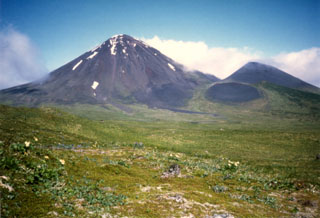Report on Semisopochnoi (United States) — 21 April-27 April 2021
Smithsonian Institution / US Geological Survey
Weekly Volcanic Activity Report, 21 April-27 April 2021
Managing Editor: Sally Sennert.
Please cite this report as:
Global Volcanism Program, 2021. Report on Semisopochnoi (United States) (Sennert, S, ed.). Weekly Volcanic Activity Report, 21 April-27 April 2021. Smithsonian Institution and US Geological Survey.
Semisopochnoi
United States
51.93°N, 179.58°E; summit elev. 1221 m
All times are local (unless otherwise noted)
Eruptive activity at Semisopochnoi gradually increased during 21-22 April based on satellite and infrasound data; ash emissions were first seen in satellite images at 1800 on 21 April and were continuous at least through 1348 on 22 April. Plumes rose to 2.4 km (8,000 ft) a.s.l. and drifted 80 km S. Sulfur dioxide emissions were also detected in satellite images on 22 April. Cloud cover mostly obscured views during 23-24 April, though possible minor ash emissions were sometimes visible. Low-level ash plumes drifting S were occasionally identified in satellite images during 24-26 April. Dense weather clouds prevented views for most of 26 April and the next day. The Aviation Color Code remained at Orange and the Volcano Alert Level remained at Watch.
Geological Summary. Semisopochnoi, the largest subaerial volcano of the western Aleutians, is 20 km wide at sea level and contains an 8-km-wide caldera. It formed as a result of collapse of a low-angle, dominantly basaltic volcano following the eruption of a large volume of dacitic pumice. The high point of the island is Anvil Peak, a double-peaked late-Pleistocene cone that forms much of the island's northern part. The three-peaked Mount Cerberus (renamed Mount Young in 2023) was constructed within the caldera during the Holocene. Each of the peaks contains a summit crater; lava flows on the N flank appear younger than those on the south side. Other post-caldera volcanoes include the symmetrical Sugarloaf Peak SSE of the caldera and Lakeshore Cone, a small cinder cone at the edge of Fenner Lake in the NE part of the caldera. Most documented eruptions have originated from Young, although Coats (1950) considered that both Sugarloaf and Lakeshore Cone could have been recently active.
Source: US Geological Survey Alaska Volcano Observatory (AVO)

